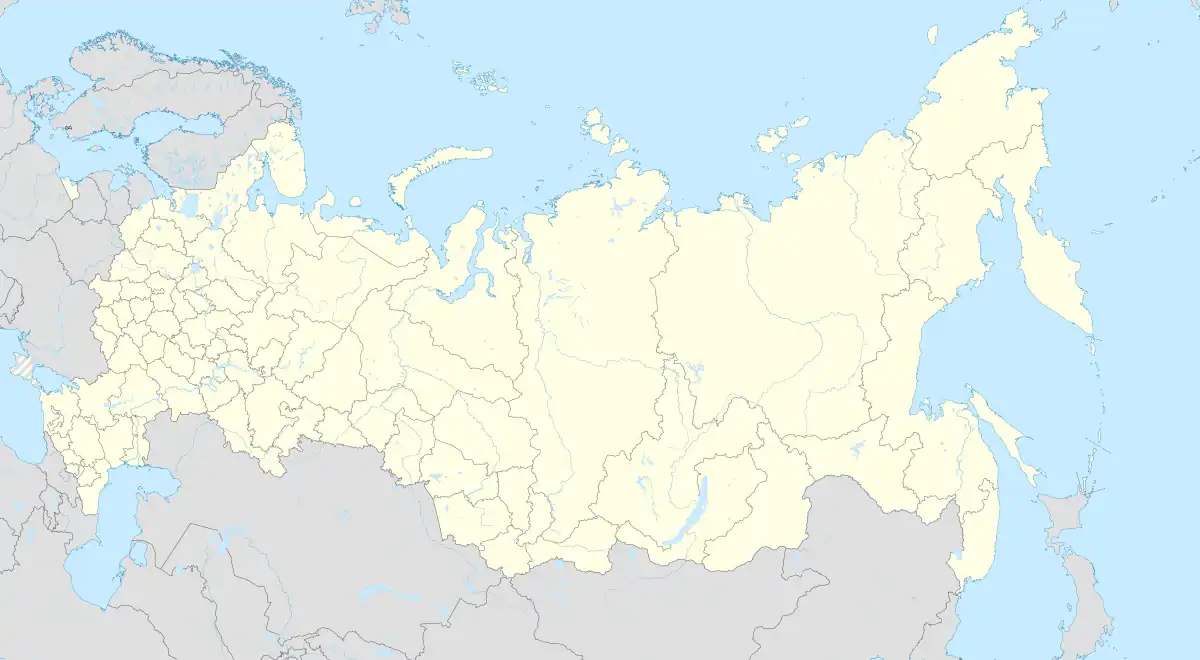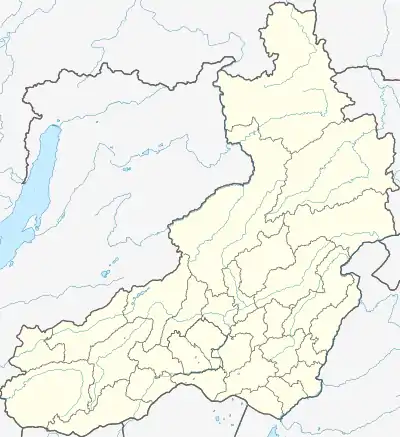Novaya Chara
Новая Чара | |
|---|---|
Location of Novaya Chara | |
 Novaya Chara Location of Novaya Chara  Novaya Chara Novaya Chara (Zabaykalsky Krai) | |
| Coordinates: 56°49′N 118°18′E / 56.817°N 118.300°E | |
| Country | Russia |
| Federal subject | Zabaykalsky Krai |
| Administrative district | Kalarsky District |
| Founded | 1979 |
| Population | |
| • Total | 4,315 |
| • Estimate (2018)[2] | 3,949 (−8.5%) |
| Time zone | UTC+9 (MSK+6 |
| Postal code(s)[4] | 674159 |
| OKTMO ID | 76615156051 |
Novaya Chara (Russian: Новая Чара) is an urban locality (an urban-type settlement) in Kalarsky District of Zabaykalsky Krai, Russia, located in the basin of the Chara River, in the eastern parts of Stanovoy Range, approximately 600 kilometers (370 mi) in a straight line northeast of the krai's administrative center of Chita, and 16 kilometers (9.9 mi) from the district's administrative center of Chara. Population: 4,315 (2010 Census);[1] 4,693 (2002 Census);[5] 8,787 (1989 Census).[6]
History
It was founded in connection to the construction of the Baikal-Amur Mainline in the 1980s, near the older village of Chara, named for the river on which it stood. The station and settlement were built by workers from the Kazakh SSR; as part of the BAM project, sections of the route were placed under the patronage of Komsomol brigades from different parts of the Soviet Union.
Regular rail traffic from Tynda in Amur Oblast to Novaya Chara began in 1988; traffic from the west of the settlement on the section from Severobaykalsk started in 1989. The completion of the BAM did not bring the expected economic development to the area, and with the economic crisis of the late 1980s, around half the population left. Nearby are the Udokan copper deposit, Chineysky vanadium deposit and Unkur silver-copper deposit.
Tourism

Novaya Chara is the starting point for trekking tours in the Kodar Mountains, as well as the Chara Sands, a 37 square kilometers (14 sq mi) area of sand dunes northwest of the settlement, across the river.
Economy
Novaya Chara's only real economic activity centers on its situation as an important station on the BAM. However, there is potential for the settlement to become the center for a mining region currently under development, with a 66-kilometer (41 mi) branch line built between 1998 and 2002 from Novaya Chara to the titanium, vanadium, and iron ore mine Chineyskoye.[7]
The Chineyskoye mine contains both Russia's largest titanium deposit, and the world's largest recorded vanadium deposit. Due to financing problems with the mines, located at an altitude of over 2,000 meters (6,600 ft), the branch line has been poorly maintained and damaged by landslides, meaning that in 2008 only 26 kilometers (16 mi) were in use; with trucks being used to transport ore to the railhead. Repair and reconstruction of the line is currently being undertaken.
Also on this branch line are the rare-earth metal mine Katuginskoye, iron ore mine Sulumatskoye, and large anthracite deposits at Chitkanda.[8]
Around 30 km (19 mi) south of Novaya Chara is the Udokan copper deposit, which is planned to be mined in future.
Around 15 km (9.3 mi) to the south west of Novaya Chara is the Unkur silver and copper deposit, which is currently under exploration.
The settlement is also serviced by a small airport.
References
- 1 2 Russian Federal State Statistics Service (2011). Всероссийская перепись населения 2010 года. Том 1 [2010 All-Russian Population Census, vol. 1]. Всероссийская перепись населения 2010 года [2010 All-Russia Population Census] (in Russian). Federal State Statistics Service.
- ↑ "26. Численность постоянного населения Российской Федерации по муниципальным образованиям на 1 января 2018 года". Federal State Statistics Service. Archived from the original on July 26, 2018. Retrieved January 23, 2019.
- ↑ "Об исчислении времени". Официальный интернет-портал правовой информации (in Russian). June 3, 2011. Retrieved January 19, 2019.
- ↑ Почта России. Информационно-вычислительный центр ОАСУ РПО. (Russian Post). Поиск объектов почтовой связи (Postal Objects Search) (in Russian)
- ↑ Russian Federal State Statistics Service (May 21, 2004). Численность населения России, субъектов Российской Федерации в составе федеральных округов, районов, городских поселений, сельских населённых пунктов – районных центров и сельских населённых пунктов с населением 3 тысячи и более человек [Population of Russia, Its Federal Districts, Federal Subjects, Districts, Urban Localities, Rural Localities—Administrative Centers, and Rural Localities with Population of Over 3,000] (XLS). Всероссийская перепись населения 2002 года [All-Russia Population Census of 2002] (in Russian).
- ↑ Всесоюзная перепись населения 1989 г. Численность наличного населения союзных и автономных республик, автономных областей и округов, краёв, областей, районов, городских поселений и сёл-райцентров [All Union Population Census of 1989: Present Population of Union and Autonomous Republics, Autonomous Oblasts and Okrugs, Krais, Oblasts, Districts, Urban Settlements, and Villages Serving as District Administrative Centers]. Всесоюзная перепись населения 1989 года [All-Union Population Census of 1989] (in Russian). Институт демографии Национального исследовательского университета: Высшая школа экономики [Institute of Demography at the National Research University: Higher School of Economics]. 1989 – via Demoscope Weekly.
- ↑ Viktor Verti: China nachinayetsya s dorogi. In Trud, 28. September 2001 (Russian)
- ↑ Article from Sergey Rinchinov from metaltorg.ru, October 17, 2008 (Russian)